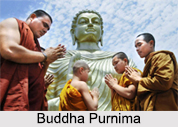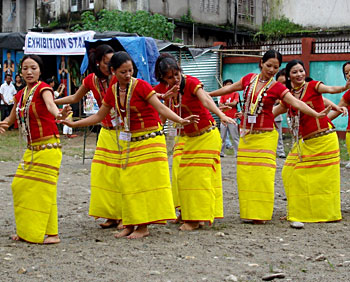 The north eastern state of Meghalaya is rich in culture and tradition and with their different tribes; the state celebrates a variety of festivals. Each tribe has its own set of festivals in which they actively participate to enhance their festive spirit and to come of their monotonous life. In fact the indigenous festivals of the state mirror its diverse heritage during the celebration of the seasonal cycle of sowing and harvesting.
The north eastern state of Meghalaya is rich in culture and tradition and with their different tribes; the state celebrates a variety of festivals. Each tribe has its own set of festivals in which they actively participate to enhance their festive spirit and to come of their monotonous life. In fact the indigenous festivals of the state mirror its diverse heritage during the celebration of the seasonal cycle of sowing and harvesting.
Most of the festivals of Meghalaya revolve around agriculture, which is the prime occupation of the people in the state. Although some religious and spiritual sentiments are interwoven into secular rites and rituals, the predominant themes of the festivals is to offer prayers to the Supreme Being who is known by different names in their different Naga dialects. But participation of all in these festivals is compulsory. Discussed below elaborately are the various festivals of Meghalaya that are celebrated by the native tribal groups:
Khasi Festivals
Known to hold a closer connection to nature, the Khasi people believe that God exists in every element of nature and thus their festivals also reflect that. Listed below are some of these festivals:
 Ka Shad Suk Mynsiem: Celebrated in the month of April as a thanksgiving to nature, Shad Suk Mynsiem is actually a type of dance that the Khasi people perform for the bountiful harvest. The women adorn themselves in traditional finery and the men dress in vibrant coloured costumes participate with much enthusiasm in the traditional dance to the accompaniment of drum beats and other musical instruments.
Ka Shad Suk Mynsiem: Celebrated in the month of April as a thanksgiving to nature, Shad Suk Mynsiem is actually a type of dance that the Khasi people perform for the bountiful harvest. The women adorn themselves in traditional finery and the men dress in vibrant coloured costumes participate with much enthusiasm in the traditional dance to the accompaniment of drum beats and other musical instruments.
Nongkrem Dance Festival: One of the most important festivals of the Khasi tribe, Nongkrem is celebrated with great pomp and enthusiasm. It is also a harvest festival and has several religious rites and rituals associated with, among which the offering of goats (also known as Pomblang ceremony) to the administrative head is the most important one. The first day of the festival is marked by a royal dance performance which takes place at the dawn. Besides the traditional dances the sword dances, music, colourful costumes and stunning jewellery enhance the spirit of the festive celebrations.
Ka Shad Shyngwiang Thangiap: The Khasi people of Meghalaya commemorate death by celebrating with Ka Shad Shyngwiang Thangiap dance that starts with the day of death and continues till the last rites of the deceased are over. The dance signifies a blessing for the departed soul for its long journey from the mortal to the spirit world. The dance starts at a place just outside the kitchen door and is supported by men who play music on flute, drums, and bamboo poles.
Garo Festivals
The Garo religion is monotheistic with a highly ritualistic polytheistic form of worship. The popular traditional Garo religion is "animistic; in nature, but they believe in a Supreme God known as "Tatara Rabuga" or "Dakgipa Rugipa".
Wangala Festival: A post harvest festival, Wangala marks the end of the agricultural year. During this festival the locals hold propitiation ceremonies in honour of the deity Patigipa Rarongipa in almost every village of the state. The people of the state follow the religious rites and rituals with much veneration for a consecutive period of 4 days and nights accompanied by unrestrained zeal and fervour. The conclusion of the festival is marked by the warrior`s dance which is indeed a magnificent and enchanting spectacle to observe.
 Jaintia Festivals
Jaintia Festivals
Festivals celebrated by the Jaintia tribe also significantly contribute to maintaining a balance between man and his culture and his natural environment.
Behdienkhlam: This is one of the most popular festivals of Meghalaya, which is celebrated during the monsoon season in the month of July at Jowai and Tuber in the hills of Jaintia. This grand festival is characterized by religious ceremonies and dancing at a pool called `eit nar` and also includes a football game called `datlawakor`. This festival is essentially celebrated to seek the blessings of the Almighty for a bounteous yield of crops in the following year and also to chase away various kind of diseases and plagues.
Lahoo Dance Festival: A form of dance festival for entertainment, the Lahoo dance is performed by both the males and females of the community. Both the men and women folks are dressed in vibrant coloured outfits. In this dance two young men on either side of a woman hold arms together and dance in step. The Lahoo Dance Festival is thus one of the most famous festivals of Meghalaya.
Thus, it can be said that every ceremony and festivals of Meghalaya from birth to death is enriched with music and dance. These festivals of Meghalaya also facilitate tourism as people from all around visit the Indian state during the annual festivities to celebrate.



















